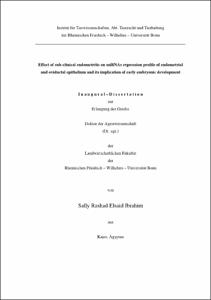Ibrahim, Sally Rashad Elsaid: Effect of sub-clinical endometritis on miRNAs expression profile of endometrial and oviductal epithelium and its implication of early embryonic development. - Bonn, 2015. - Dissertation, Rheinische Friedrich-Wilhelms-Universität Bonn.
Online-Ausgabe in bonndoc: https://nbn-resolving.org/urn:nbn:de:hbz:5n-39609
Online-Ausgabe in bonndoc: https://nbn-resolving.org/urn:nbn:de:hbz:5n-39609
@phdthesis{handle:20.500.11811/6232,
urn: https://nbn-resolving.org/urn:nbn:de:hbz:5n-39609,
author = {{Sally Rashad Elsaid Ibrahim}},
title = {Effect of sub-clinical endometritis on miRNAs expression profile of endometrial and oviductal epithelium and its implication of early embryonic development},
school = {Rheinische Friedrich-Wilhelms-Universität Bonn},
year = 2015,
month = mar,
volume = 175,
note = {Understanding the molecular mechanisms associated with regulation of inflammatory responses during female genital tract infection is one step forward for development of diagnostic and therapeutic strategies in bovine reproduction. Therefore, the aim of this thesis was to investigate post-transcriptional regulation of inflammatory immune response genes during LPS treatment in bovine oviductal, endometrial cells and embryos. For this, two studies were conducted. In the first study, the mRNA expression analysis of inflammatory response genes (TNFα & IL1β) was performed in primary bovine oviductal cell culture and co-cultured blastocysts after minimum dose of LPS treatment in vitro. In the second study, the alterations of let-7 miRNAs expression were addressed in primary bovine endometrial cells after LPS challenge (with clinical dose of 3.0 μg/ml or a sub-clinical dose of 0.5 μg/ml), as well as functional study of let-7 miRNAs using gain and loss of function. While LPS treatment resulted in significantly up-regulation of pro-inflammatory cytokines (TNFα & IL1β) and stress response genes (SOD & CAT) in bovine oviductal cell and co-cultured blastocysts, the expression level of essential elements like OVGP1 and IGF2 was reduced in the challenged group compared to the untreated control. Interestingly, the over-expression of these proinflammatory cytokines in bovine oviductal cells was associated with aberrant expression of their potential regulatory miRNAs (miR-155, miR-146a, miR-223, miR- 21, miR-16 and miR-215). Furthermore, blastocysts co-cultured with oviductal cells in the presence of LPS showed reduced mitochondrial distribution pattern, higher ROS and apoptotic cells. A minimum dose of LPS challenge resulted in changes in relative abundance of let-7 miRNAs in a time dependent-manner, where the peak expression of let-7a reached at 6h, while let-7e, let-f and let-7i peaked at 24h post treatment. Overexpression of let-7a inhibited pro-inflammatory cytokines (TNFα & IL6) on mRNAs as well as protein levels, while the let-7a inhibitor (antagonist) resulted in an increase in the expression of the same genes. The mRNAs and protein levels of TNFα, IL6 have shown a clear suppression upon transfection with let-7f inhibitor. In conclusion, infections in endometrial or oviductal microenvironment resulted in aberrant expression of genes and miRNAs which support the role of regulatory let-7 miRNAs during bovine uterine infection by fine-tuning inflammatory cytokines.},
url = {https://hdl.handle.net/20.500.11811/6232}
}
urn: https://nbn-resolving.org/urn:nbn:de:hbz:5n-39609,
author = {{Sally Rashad Elsaid Ibrahim}},
title = {Effect of sub-clinical endometritis on miRNAs expression profile of endometrial and oviductal epithelium and its implication of early embryonic development},
school = {Rheinische Friedrich-Wilhelms-Universität Bonn},
year = 2015,
month = mar,
volume = 175,
note = {Understanding the molecular mechanisms associated with regulation of inflammatory responses during female genital tract infection is one step forward for development of diagnostic and therapeutic strategies in bovine reproduction. Therefore, the aim of this thesis was to investigate post-transcriptional regulation of inflammatory immune response genes during LPS treatment in bovine oviductal, endometrial cells and embryos. For this, two studies were conducted. In the first study, the mRNA expression analysis of inflammatory response genes (TNFα & IL1β) was performed in primary bovine oviductal cell culture and co-cultured blastocysts after minimum dose of LPS treatment in vitro. In the second study, the alterations of let-7 miRNAs expression were addressed in primary bovine endometrial cells after LPS challenge (with clinical dose of 3.0 μg/ml or a sub-clinical dose of 0.5 μg/ml), as well as functional study of let-7 miRNAs using gain and loss of function. While LPS treatment resulted in significantly up-regulation of pro-inflammatory cytokines (TNFα & IL1β) and stress response genes (SOD & CAT) in bovine oviductal cell and co-cultured blastocysts, the expression level of essential elements like OVGP1 and IGF2 was reduced in the challenged group compared to the untreated control. Interestingly, the over-expression of these proinflammatory cytokines in bovine oviductal cells was associated with aberrant expression of their potential regulatory miRNAs (miR-155, miR-146a, miR-223, miR- 21, miR-16 and miR-215). Furthermore, blastocysts co-cultured with oviductal cells in the presence of LPS showed reduced mitochondrial distribution pattern, higher ROS and apoptotic cells. A minimum dose of LPS challenge resulted in changes in relative abundance of let-7 miRNAs in a time dependent-manner, where the peak expression of let-7a reached at 6h, while let-7e, let-f and let-7i peaked at 24h post treatment. Overexpression of let-7a inhibited pro-inflammatory cytokines (TNFα & IL6) on mRNAs as well as protein levels, while the let-7a inhibitor (antagonist) resulted in an increase in the expression of the same genes. The mRNAs and protein levels of TNFα, IL6 have shown a clear suppression upon transfection with let-7f inhibitor. In conclusion, infections in endometrial or oviductal microenvironment resulted in aberrant expression of genes and miRNAs which support the role of regulatory let-7 miRNAs during bovine uterine infection by fine-tuning inflammatory cytokines.},
url = {https://hdl.handle.net/20.500.11811/6232}
}






